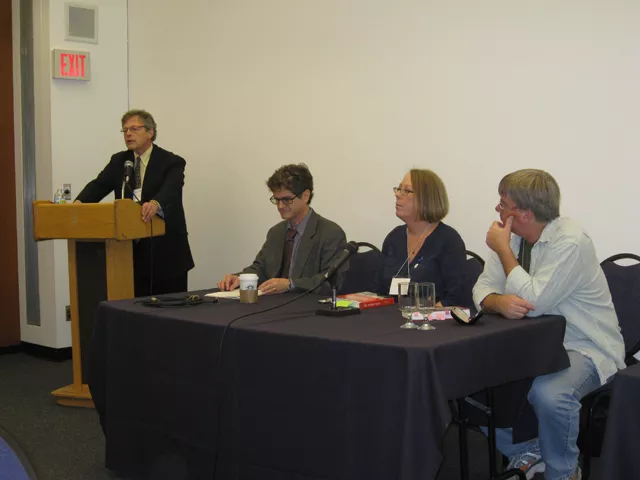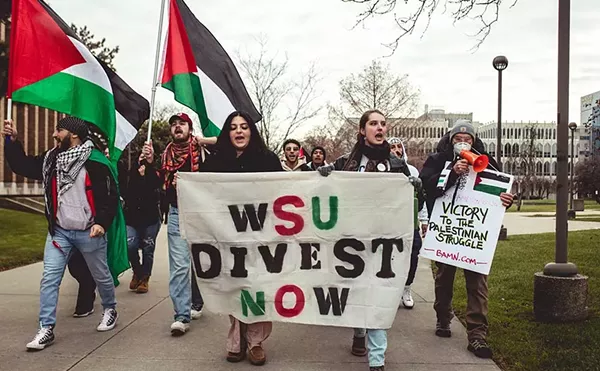
During a panel discussion last week about the book The Broken Table, which provides a detailed examination of the Detroit newspaper strike, there came a moment when Barb Ingalls had to stop and compose herself.
A member of the typographical union, Ingalls' struggle to keep her emotions in check revealed just how deep the wounds of that bitterly divisive and fiercely fought strike still run.
Just reading the book, written by Chris Rhomberg, a Fordham University associate sociology professor, proved difficult, Ingalls told a small group of people attending the discussion.
Moderated by MT columnist Jack Lessenberry, the session was part of the North American Labor History Conference held at Wayne State.
Ingalls' difficulty making it through the book didn't have anything to do with its readability. As noted by panelist Scott Martelle, a former Detroit News striker who has written some notable books himself, Rhomberg's book combines rigorous academic research with superb storytelling.
What has made the reading difficult, explained Ingalls, are the memories and emotions the book dredges up.
On July 13, 1995, some 2,500 unionized employees went on strike against the Detroit Free Press, the Detroit News and Detroit Newspaper Agency, the name at the time for the unit that oversaw business operations for the two daily newspapers.
After months of protests, picket lines and sometimes violent street clashes, the unions made an unconditional offer to return to work in February 1997. But the companies, as Rhomberg writes, "announced that they would take back only a fraction of the striking workers, as new vacancies allowed."
Years of litigation ensued, culminating with a July 2000 federal Appeals Court ruling in favor of the companies that essentially forced the unions to "accept contracts on management's terms."
The story of Detroit's newspaper strike speaks to larger issues that have been negatively affecting organized labor for decades, Rhomberg contends.
"As remarkable as it may have seemed, the Detroit newspaper strike was not an isolated event. The period of the 1980s and 1990s witnessed a series of hard, wrenching strikes in American industry," he writes.
What we've witnessed, according to Rhomberg, is a profound shift in the social contract that existed between management and organized labor. Instead of two sides bargaining to get the best deal possible, what developed instead was an attempt by management to simply crush labor, at almost any cost.
The Detroit newspaper strike — reluctantly launched by the unions because of unfair labor practices — placed in high relief an approach where, as Rhomberg told an audience that contained a handful of former strikers, "one side comes to the table looking to make a deal, and the other side comes looking to eliminate the table."
From a labor standpoint, this tactic has been depressingly effective. Rhomberg writes:
"For decades now, the hostile environment for labor has accelerated the decline of union density in the American economy; by 2004 the proportion of the private-sector labor force belonging to unions had fallen below 8 percent, a level not seen since before the New Deal."
In terms of the Detroit strike, Rhomberg said, the unions failed to fully understand "the depths of anti-union sentiment" at Gannett, then owner of the News, now owner of the Free Press, and always the dominant partner in the papers' partnership that began in 1989. (The launch of the partnership followed a long legal battle, but that's another story.)
"For the unions," Rhomberg writes, "the key issues igniting the 1995 strike were not wages but complaints of employer unfair labor practices. Two of the complaints involved unilateral changes limiting the unions' ability to bargain over compensation and working conditions, and the third was in defense of the joint bargaining procedure that had led successfully to a contract in 1992. ...
"In short, the strike was fundamentally not about the traditional dollars and cents, but about the control of the workplace and the future of the bargaining relationship."
The attitude of the companies certainly reflects that thinking.
"None of the top executives interviewed for this book could recall any conversations in which they seriously considered compromising with the unions' position in order to end the strike quickly or minimize its economic and social costs," Rhomberg writes.
The unions weren't prepared to deal with that sort of absolute intransigence on the part of management.
What the outside owners didn't get was the degree to which Detroit strikers would stand their ground, and the degree of support they would receive from the public at large. As reported in his book, the two papers combined "lost nearly $100 million in just the first six months of the strike, with circulation dropping by as much as one-third."
On top of that, the companies spent "an estimated $40 million on private security forces and paid more than $1 million to suburban municipalities to cover police overtime at their production and distribution sites."
One aspect of the profound change that has taken place in recent decades is the use of a strike as a negotiating tactic.
Writes Rhomberg: "The strike itself has almost disappeared: during the 1970s, an average of 289 major work stoppages involving a thousand or more workers occurred annually in the United States. By the 1990s, that number had declined to about 35 per year, and in 2009 there were no more than five."
In short, he writes, what we've seen is a "renewed corporate offensive against unions since around 1980, the erosion of collective bargaining, and the failure of traditional legal protections for workers."
One of the lessons learned from the Detroit strike is that labor can't depend on the courts. Even if unions do eventually get favorable rulings, the ability of management to stretch things out for years works to the detriment of unions.
Saying "justice delayed is justice denied," Rhomberg told his audience that "if you have to fight it out in the courts, you lose."
Instead, the key to success is creating "small, localized social movements to achieve what you want."
But it's not easy.
One of the most illuminating things that came out of lawsuits associated with the strike has to do with the ability of corporations to buy off law enforcement. As Rhomberg reports, civil rights suits brought by strikers "revealed a pattern of collusion between the newspapers and the Sterling Heights Police Department."
At one point during last week's talk, the discussion turned to the question, "Who won?"
Ingalls, who described seeing her husband Bob, a UAW member, beaten to the ground by cops, talked about the very real feelings of solidarity the strike generated, and the raising of consciousness that resulted.
The way she sees it, the papers suffered losses that they haven't really recovered from. And the unions remain, having retained the right to bargain collectively.
So, in that sense, it was a victory for labor.
Others described the outcome as a "draw."
But as we sat listening to Ingalls talk about the buyouts currently under way at the Free Press, and the skill level and institutional memory being lost as a result, we wondered.
In terms of the quality of daily print journalism in this town, she predicted, "It's going to get worse."
If that's the case, we asked, aren't we all losers?
No one disagreed.
But there's an even bigger picture, one that seems at the heart of The Broken Table, and last week's labor conference as well.
"The newspaper strike represented the exceptional struggle of one community during the decade of the 1990s," Rhomberg writes at the conclusion of his book, "but every generation must decide which rules will govern its collective economic, political and social relationships. We need not dismiss cases like Detroit as mere outliers or historical failures; such moments, when all involved do their worst and best, can teach us something about crucial institutional conflicts and paths of change."






